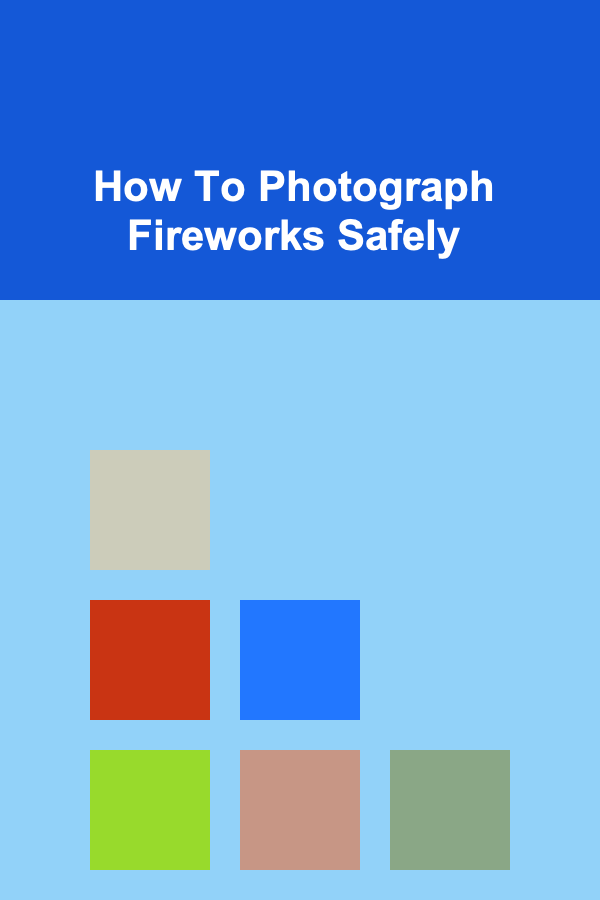
How To Photograph Fireworks Safely
ebook include PDF & Audio bundle (Micro Guide)
$12.99$8.99
Limited Time Offer! Order within the next:

Fireworks photography is one of the most exciting and visually captivating types of photography. Whether it's for personal enjoyment, a celebration, or capturing memories for a community event, photographing fireworks offers an incredible opportunity to experiment with light and motion. However, photographing fireworks requires careful planning, technical knowledge, and a focus on safety. This article will guide you through the process of safely photographing fireworks while ensuring that you get stunning results.
Understanding Fireworks Photography
Fireworks photography combines art and science. Capturing fireworks is a unique challenge because you're dealing with fleeting moments of intense light and motion. Unlike traditional photography subjects that remain still or have controlled lighting, fireworks are unpredictable and require precise timing and technique. However, with the right approach, you can capture stunning images that reflect the vibrant and explosive nature of fireworks.
The Basics of Fireworks Photography
Before diving into the technical aspects, it's important to have a solid understanding of how fireworks behave in the sky. Fireworks are often shot from the ground or launched from a platform, exploding at varying heights and producing colorful trails of light. These explosions of light are brief, usually lasting only a few seconds, so timing is everything when photographing them.
In addition to the timing, fireworks are often set off in sequences, creating a beautiful pattern in the sky. As the night sky becomes illuminated by these fiery bursts, you will need to capture the right balance of exposure, focus, and composition to preserve the beauty of the moment.
Essential Equipment for Fireworks Photography
To capture stunning fireworks images, you will need to equip yourself with the proper gear. While some may think that any camera is suitable, there are certain pieces of equipment that will increase your chances of success.
1. Camera
You will need a camera that allows manual control over settings such as shutter speed, aperture, and ISO. A DSLR or mirrorless camera is ideal for fireworks photography because it gives you full control over these settings. A camera with a larger sensor size (such as a full-frame sensor) will allow more light into the lens, providing better results in low-light conditions.
2. Lens
For fireworks photography, a wide-angle lens is typically the best choice. A lens with a focal length between 18mm and 35mm is ideal, as it will allow you to capture the entire firework display in the frame. A wide-angle lens also helps capture the surrounding environment, providing context to the scene.
Additionally, a lens with a wide aperture (f/2.8 or lower) is beneficial for shooting in low light. However, if you want to capture more of the sky and keep the fireworks in focus from a distance, a telephoto lens might come in handy.
3. Tripod
Because fireworks are typically shot in low light conditions, a tripod is essential. A tripod will keep your camera stable during long exposure shots, preventing motion blur. Fireworks photography often involves long exposure times, sometimes up to several seconds, so using a tripod will ensure sharp images and allow you to capture the full brilliance of the fireworks.
4. Remote Shutter Release or Timer
To avoid camera shake, it's recommended to use a remote shutter release or a camera timer. Pressing the shutter button manually can introduce small movements that can result in blurry images, so using a remote trigger ensures a smoother, more stable shot.
5. ND Filter (Optional)
A Neutral Density (ND) filter can be helpful when you're photographing fireworks during daylight or at dusk. This filter reduces the amount of light entering the camera, allowing you to use longer exposures even in bright conditions. While it's not necessary in every situation, it can help you achieve the desired exposure.
6. Lens Hood
A lens hood can protect your lens from unwanted light sources and also shield it from smoke or debris that might result from fireworks.
Setting Up for Fireworks Photography
Once you have the necessary equipment, the next step is to prepare your gear and choose the perfect location for capturing fireworks. Here's how to do it:
1. Choose the Right Location
Selecting the right spot is crucial for great fireworks photography. Look for a location that offers a clear, unobstructed view of the sky. This could be a park, an open field, or any place where the fireworks are visible without interference from trees, buildings, or other structures.
Be sure to take into account the safety regulations of the area, such as any restricted zones or areas where spectators are not allowed. Avoid placing yourself too close to the fireworks launch site, as the noise and danger can be overwhelming.
If you want to include some foreground elements in your shots, such as buildings, water, or trees, choose a location that offers both a good view of the fireworks and an interesting foreground.
2. Arrive Early
Arriving early will allow you to scout your location, set up your gear, and get comfortable with your surroundings. It will also give you time to adjust your camera settings before the fireworks start. In addition, arriving early will help you avoid crowds and ensure that you have the best possible spot.
3. Set Up Your Tripod and Camera
Once you've chosen a spot, set up your tripod and mount your camera. Make sure the camera is level and stable. Check the horizon line to ensure you're framing your shots appropriately.
If possible, position the camera so that you can capture multiple fireworks at once. The beauty of fireworks photography lies in the timing, so be sure you have a good vantage point to capture a wide range of bursts and explosions.
4. Set Your Camera Settings
Now that your camera is in place, it's time to adjust the settings. The settings you use will depend on the type of shot you want to capture, but here are some general guidelines for fireworks photography:
- Shutter Speed: Fireworks require long exposure times to capture the full effect of the explosion. Start with a shutter speed between 2-4 seconds. This allows you to capture the full burst without overexposing the image. If the fireworks are moving too quickly, decrease the shutter speed to capture sharper details.
- Aperture: Set your aperture to a value between f/8 and f/16. A smaller aperture (higher f-number) will ensure that both the fireworks and the foreground remain in focus. Be careful not to go too small, as this can result in less light being captured.
- ISO: Keep your ISO as low as possible, preferably between 100 and 400, to avoid noise in the image. Fireworks are bright enough that you don't need to raise the ISO significantly.
- Focus: Set your lens to manual focus and focus to infinity. Autofocus can be unreliable in low-light conditions, so manual focus ensures sharp images.
- White Balance: Set the white balance to "daylight" or "tungsten" to preserve the colors of the fireworks. You can adjust the white balance later in post-processing if needed.
5. Take Test Shots
Before the fireworks begin, take a few test shots to evaluate your exposure settings. Adjust your shutter speed, aperture, and ISO as needed. Make sure the image is not too overexposed, and check the sharpness and focus.
Photographing the Fireworks
When the fireworks begin, timing and patience are essential. Here are some tips for capturing the best fireworks photos:
1. Capture the Entire Display
Fireworks often follow a predictable sequence of bursts. Make sure to capture the entire explosion by leaving your shutter open long enough to include multiple fireworks in the frame. A longer exposure will allow you to capture trails of light from each burst.
2. Experiment with Exposure Times
Try different exposure times to see what works best for the specific fireworks display. For example, if you want to capture individual fireworks bursts in more detail, try shorter exposures (1-2 seconds). If you prefer to capture the streaks of light and motion, opt for longer exposures.
3. Use the Bulb Mode
Many photographers use the "Bulb" mode for fireworks photography. This allows you to control the exposure time manually by holding down the shutter button. When using the Bulb mode, you can decide how long to leave the shutter open based on the fireworks' timing. You can experiment with this technique to achieve unique effects and compositions.
4. Capture Different Angles
While it's easy to shoot fireworks from a single spot, capturing them from different angles can add variety and interest to your collection. If possible, move around or zoom in for more detailed shots.
5. Use Multiple Shots
Since fireworks can be unpredictable, it's a good idea to take multiple shots during the display. Experiment with various settings and compositions. Don't hesitate to shoot in burst mode if your camera supports it.
Post-Processing Fireworks Photos
Once the fireworks show is over, the work doesn't stop there. Post-processing your photos is an essential step in making them stand out. Here are some post-processing tips for fireworks photos:
1. Adjust Exposure
If your image is too dark or too bright, you can adjust the exposure in post-processing. Tools like Lightroom or Photoshop allow you to fine-tune the exposure, contrast, and brightness to achieve the desired effect.
2. Enhance Colors
Fireworks often produce vibrant colors, and post-processing can help bring these out. Increase the vibrancy or saturation to make the colors pop. You can also adjust the white balance to correct any color casts.
3. Sharpen the Image
Since fireworks photography often involves long exposures, it's common to have some slight softness in your images. You can sharpen the image using editing software, but be careful not to overdo it, as this can introduce noise.
4. Remove Unwanted Elements
Sometimes, there may be distracting elements in your fireworks photos, such as people, debris, or light pollution. Use the cloning tool or healing brush in Photoshop to remove unwanted elements from the frame.
Safety Considerations
While capturing the beauty of fireworks is thrilling, safety should always be your priority. Here are some safety guidelines to follow:
- Distance: Keep a safe distance from the fireworks launch site. Follow the instructions of event organizers and avoid going into restricted areas.
- Protect Your Eyes: Always wear protective eyewear to shield your eyes from debris and bright flashes.
- Protect Your Gear: Fireworks can emit smoke and sparks. Use a lens hood to protect your camera lens from debris, and keep a microfiber cloth handy to clean your lens between shots.
- Stay Aware of Your Surroundings: Fireworks shows often attract large crowds. Be mindful of people around you, and never get too close to the launch site or use your camera in a way that obstructs others' views.
Conclusion
Photographing fireworks is a rewarding and exciting challenge that requires technical skills, creativity, and a strong focus on safety. By choosing the right equipment, setting up your camera properly, experimenting with different techniques, and processing your images thoughtfully, you can capture breathtaking fireworks photos. Always prioritize safety, and enjoy the thrill of documenting this beautiful spectacle.

How to Create a Home Gym Without Taking Up a Lot of Space
Read More
How to Keep Your Rental Property Safe and Secure for Tenants
Read More
How to Soundproof Your Home for Better Sleep Quality
Read More
How To Build a Successful Franchise (Small Business Focus)
Read More
How to Diagnose and Fix Common Microphone Issues
Read More
How to Create Realistic Paper Flowers for Home Decor
Read MoreOther Products

How to Create a Home Gym Without Taking Up a Lot of Space
Read More
How to Keep Your Rental Property Safe and Secure for Tenants
Read More
How to Soundproof Your Home for Better Sleep Quality
Read More
How To Build a Successful Franchise (Small Business Focus)
Read More
How to Diagnose and Fix Common Microphone Issues
Read More